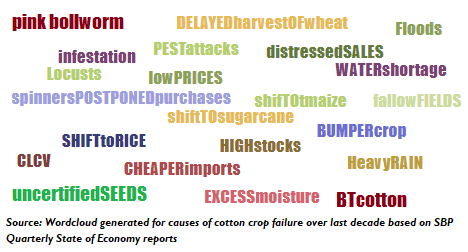For the first time in history, the Cotton Crop Assessment Committee has set a lower yield target for Punjab’s crop than it claims to have achieved during the preceding year. At a time when global cotton prices are resurgent and the crop in short supply domestically, what explains the underwhelming expectations from cotton in the upcoming sowing season?
The easiest explanation, of course, is that the yield claimed to have been achieved in the outgoing year is inaccurate and may see a significant downward revision once the final figures are announced. That would mean that the government is finally ‘keeping it real’; as it is far easier to surpass mediocre targets than to aim high and fail miserably. But that raises very tragic implications for public policymaking, calling into question the very wisdom of target-setting, a subject best left for another day.

With acreage under the crop at an all-time low, traditional wisdom dictates that only the most efficient growers must stick to the crop, especially given the opportunity to shift to more profitable choices that are also less risky. So why does the government expect so little out of cotton farmers?
A survey of SBP’s State of the Economy reports over the past decade reveals that those responsible have implicated nearly every reason imaginable for falling crop productivity. It is as if that in coming years only those with gambling instincts would continue to bet long on the crop, hoping to hit big in the face of adversity.
That would matter little if the policymakers had the gumption to leave things to market forces, which - given the overwhelming threats to crop’s survival - may lead to its eventual extinction. Except that the ever-increasing reliance on the textile sector for precious export dollars mean that alarm is routinely raised over its dismal performance. Yet, it appears that the same tried-tested-and-failed solutions are dusted off and proposed each time, like a staircase that leads to nowhere.

Consider that the ministry of National Food Security & Research has once again floated the proposal of instituting a minimum support price and procurement by Trade Corporation of Pakistan to revive area under the crop. Never mind the epic failure government footprint has been in procurement of other crops such as wheat or sugarcane. Are the overlords at the ministry blissfully unaware of the shrinking fiscal space, rendering such schemes no better than fantasies?
If the crop failure of last 10 years have made one thing obvious, it is that this highly risk-prone cotton crop needs 21st century risk mitigation and management solutions, whether they come in the form of crop insurance, price stability through trading over commodity exchanges, contract farming, warehouse receipt financing, or adoption of technology. Which of those proposals may be best suited to unique local setting must be debated comprehensively by both the stakeholders and the public before their adoption.
But that would require stepping out of the comfort zone afforded by political grandstanding. And if the events over past week are anything to go by, that’s one thing the ruling party seems resolutely incapable of.

























Comments
Comments are closed.